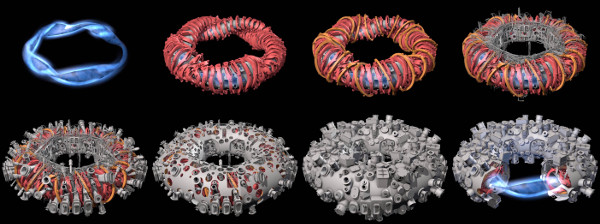Successfully built Stellarator-type thermonuclear reactor
After 19 years of research, 1.1 million hours of tireless work, costing more than 1 billion euros, eventually the scientists at the Max Planck Institute built the completed Wendelstein 7-X - a reactor that combines The largest Stellarator-type nuclear node ever. The journey to find the almost eternal energy source for mankind has taken a step forward, the "unfounded horse" has been tamed and served humans?
Successfully built the world's largest Stellarator thermonuclear reactor
Until now, besides wind, ocean or solar energy, scientists have always thought of nuclear reactions as a way to help mankind relieve the thirst for energy that is increasingly pressing.The most promising type of reaction is nuclear fusion (nuclear fusion reaction, fusion reaction). However, this is still "an unequal horse" that so far, scientists have not yet been able to control the reaction and produce available energy.
One of the most promising approaches to implementing reactions is the Tokamak toroidal magnetic field device made by the Soviet Union to confine the internal plasma to maintain the fusion reaction. Currently, the world still has about 100 active Tokamak-type devices but despite many years, through generations X and XX, Tokamak has not been able to create the available energy level to build power plants due to many weaknesses. points can not pass.

Another approach is the Stellarator-type device . It is similar to Tokamak, confining superheated gas inside a magnetic field to maintain a reaction. However, both have the overall structure created from the donut shaped field and it suffers from the disadvantage: the closer the magnetic field is to the center, the stronger it will get out of the outer edge.
However, the difference of Stellarator and Tokamak is how to solve the problem . Tokamak uses electric current to twist electrons and ions in the plasma, creating a vertical loop as well as a horizontal in the donut. However, due to the use of electricity, when there is a problem with electricity, the magnetic field will be broken and the reactor will be damaged, very dangerous.
In contrast, the Stellarator creates this horizontal loop with the original design of the device, adding coils to the donut. However, this approach makes Stellarator harder to build than Tokamak although it has the advantage of not needing to use electricity. But if the building is successful, the reaction will be more secure because the magnetic field is made up of coils wrapped around it, keeping the plasma inside.
Now, after years of research, Wendelstein 7-X - the world's largest Stellarator thermonuclear reactor has been built by scientists at the Max Planck Institute in Germany. It is known that the researchers used supercomputer help to design the shape of the furnace with extremely high precision to boost the reaction efficiency to the desired level.

Now, the work of researchers is just waiting for approval from the German Nuclear Regulatory Agency to be able to operate the reactor. If all goes well, all procedures will be completed in October and the furnace will officially go into operation. This is not just a simple power plant but the successful construction of Wendelstein 7-X is also considered an event that can change the world.
This success will be replicated, creating zero-emissions, extremely high-efficiency power plants, and according to Professor Thomas Klinger, the reactor construction project manager, "Imagine this reactor. You only need to use 3 bottles of water to supply electricity for an entire household throughout the year " . It is not exaggerating to say that energy seems to be only on the stars that have been successfully created by humans.
Video introduces the structure and operation of the furnace:
- Successful invention of a clean electric furnace
- The most powerful thermonuclear bombs in the world
- NASA: Mars nuclear reactor was successfully tested
- NASA successfully tested Mars's nuclear reactor
- China successfully tested 'Artificial Sun'
- The deadly ashes died from the first American thermonuclear bomb test
- The mystery behind the arc reactor in the Iron Man armor
- The reactor converts greenhouse gas emissions into fuel
- Video: Environmental disaster when exploding a thermonuclear bomb in the Pacific
- Russia produces super-electromagnetic weapons
- Vietnam successfully fabricated multi-purpose dehumidifier and drying machine
- Russian alloys increase the life of the reactor by 100 years
 Norway built the world's tallest wooden tower
Norway built the world's tallest wooden tower Kremlin
Kremlin Ashurbanipal: The oldest royal library in the world
Ashurbanipal: The oldest royal library in the world Decoding the thousand-year construction of Qin Shihuang shocked the world
Decoding the thousand-year construction of Qin Shihuang shocked the world Watch the 8 virtual experiments
Watch the 8 virtual experiments  In 2030, the fusion power plant was born
In 2030, the fusion power plant was born  Balance chemical reaction with EBAS
Balance chemical reaction with EBAS  There is going to be unlimited clean energy thanks to nuclear reactions
There is going to be unlimited clean energy thanks to nuclear reactions  Create 'Sun' with lasers for clean energy
Create 'Sun' with lasers for clean energy  Acid rain and its effects
Acid rain and its effects 